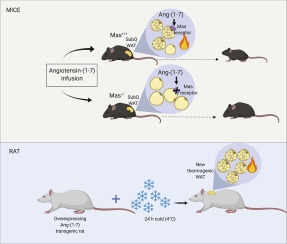当前位置:
X-MOL 学术
›
Metabolism
›
论文详情
Our official English website, www.x-mol.net, welcomes your
feedback! (Note: you will need to create a separate account there.)
Angiotensin-(1-7) induces beige fat thermogenesis through the Mas receptor.
Metabolism ( IF 10.8 ) Pub Date : 2019-12-13 , DOI: 10.1016/j.metabol.2019.154048 Ariana Vargas-Castillo 1 , Sandra Tobon-Cornejo 2 , Leonardo Del Valle-Mondragon 3 , Ivan Torre-Villalvazo 2 , Alejandro Schcolnik-Cabrera 2 , Martha Guevara-Cruz 2 , Edgar Pichardo-Ontiveros 2 , Rebeca Fuentes-Romero 2 , Michael Bader 4 , Natalia Alenina 5 , Antonio Vidal-Puig 6 , Enrique Hong 7 , Nimbe Torres 2 , Armando R Tovar 2
Metabolism ( IF 10.8 ) Pub Date : 2019-12-13 , DOI: 10.1016/j.metabol.2019.154048 Ariana Vargas-Castillo 1 , Sandra Tobon-Cornejo 2 , Leonardo Del Valle-Mondragon 3 , Ivan Torre-Villalvazo 2 , Alejandro Schcolnik-Cabrera 2 , Martha Guevara-Cruz 2 , Edgar Pichardo-Ontiveros 2 , Rebeca Fuentes-Romero 2 , Michael Bader 4 , Natalia Alenina 5 , Antonio Vidal-Puig 6 , Enrique Hong 7 , Nimbe Torres 2 , Armando R Tovar 2
Affiliation

|
OBJECTIVE
Angiotensin-(1-7) [Ang-(1-7)], a component of the renin angiotensin system, is a vasodilator that exerts its effects primarily through the Mas receptor. The discovery of the Mas receptor in white adipose tissue (WAT) suggests an additional role for this peptide. The aim of the present study was to assess whether Ang-(1-7) can induce the expression of thermogenic genes in white adipose tissue and increase mitochondrial respiration in adipocytes.
MATERIALS/METHODS
Stromal Vascular fraction (SVF)-derived from mice adipose tissue was stimulated for one week with Ang-(1-7), then expression of beige markers and mitochondrial respiration were assessed. Mas+/+ and Mas-/- mice fed a control diet or a high fat-sucrose diet (HFSD) were exposed to a short or long term infusion of Ang-(1-7) and body weight, body fat, energy expenditure, cold resistance and expression of beige markers were assessed. Also, transgenic rats overexpressing Ang-(1-7) were fed with a control diet or a high fat-sucrose diet and the same parameters were assessed. Ang-(1-7) circulating levels from human subjects with different body mass index (BMI) or age were measured.
RESULTS
Incubation of adipocytes derived from SVF with Ang-(1-7) increased the expression of beige markers. Infusion of Ang-(1-7) into lean and obese Mas+/+mice also induced the expression of Ucp1 and some beige markers, an effect not observed in Mas-/- mice. Mas-/- mice had increased body weight gain and decreased cold resistance, whereas rats overexpressing Ang-(1-7) showed the opposite effects. Overexpressing rats exposed to cold developed new thermogenic WAT in the anterior interscapular area. Finally, in human subjects the higher the BMI, low circulating concentration of Ang-(1-7) levels were detected. Similarly, the circulating levels of Ang-(1-7) peptide were reduced with age.
CONCLUSION
These data indicate that Ang-(1-7) stimulates beige markers and thermogenesis via the Mas receptor, and this evidence suggests a potential therapeutic use to induce thermogenesis of WAT, particularly in obese subjects that have reduced circulating concentration of Ang-(1-7).
中文翻译:

血管紧张素 (1-7) 通过 Mas 受体诱导米色脂肪产热。
目的 血管紧张素-(1-7) [Ang-(1-7)] 是肾素血管紧张素系统的一种成分,是一种主要通过 Mas 受体发挥作用的血管扩张剂。在白色脂肪组织 (WAT) 中发现 Mas 受体表明该肽具有额外的作用。本研究的目的是评估 Ang-(1-7) 是否可以诱导白色脂肪组织中产热基因的表达并增加脂肪细胞中的线粒体呼吸。材料/方法 用 Ang-(1-7) 刺激源自小鼠脂肪组织的基质血管部分 (SVF) 一周,然后评估米色标志物的表达和线粒体呼吸。喂食对照饮食或高脂肪-蔗糖饮食 (HFSD) 的 Mas+/+ 和 Mas-/- 小鼠暴露于短期或长期输注 Ang-(1-7) 和体重、体脂、能量消耗、评估了耐寒性和米色标记的表达。此外,用对照饮食或高脂肪蔗糖饮食喂养过度表达 Ang-(1-7) 的转基因大鼠,并评估相同的参数。测量了具有不同体重指数 (BMI) 或年龄的人类受试者的 Ang-(1-7) 循环水平。结果 SVF 脂肪细胞与 Ang-(1-7) 的孵育增加了米色标记的表达。将 Ang-(1-7) 输注到瘦和肥胖的 Mas+/+ 小鼠中也诱导了 Ucp1 和一些米色标记的表达,这种效果在 Mas-/- 小鼠中未观察到。Mas-/- 小鼠体重增加增加,抗寒能力降低,而过度表达 Ang-(1-7) 的大鼠表现出相反的效果。暴露于寒冷的过度表达大鼠在前肩胛间区域发展出新的产热 WAT。最后,在人类受试者中,BMI 越高,检测到的 Ang-(1-7) 水平循环浓度越低。同样,Ang-(1-7) 肽的循环水平随着年龄的增长而降低。结论 这些数据表明 Ang-(1-7) 通过 Mas 受体刺激米色标志物和产热,并且该证据表明潜在的治疗用途可诱导 WAT 产热,特别是在 Ang-(1) 循环浓度降低的肥胖受试者中-7).
更新日期:2019-12-13
中文翻译:

血管紧张素 (1-7) 通过 Mas 受体诱导米色脂肪产热。
目的 血管紧张素-(1-7) [Ang-(1-7)] 是肾素血管紧张素系统的一种成分,是一种主要通过 Mas 受体发挥作用的血管扩张剂。在白色脂肪组织 (WAT) 中发现 Mas 受体表明该肽具有额外的作用。本研究的目的是评估 Ang-(1-7) 是否可以诱导白色脂肪组织中产热基因的表达并增加脂肪细胞中的线粒体呼吸。材料/方法 用 Ang-(1-7) 刺激源自小鼠脂肪组织的基质血管部分 (SVF) 一周,然后评估米色标志物的表达和线粒体呼吸。喂食对照饮食或高脂肪-蔗糖饮食 (HFSD) 的 Mas+/+ 和 Mas-/- 小鼠暴露于短期或长期输注 Ang-(1-7) 和体重、体脂、能量消耗、评估了耐寒性和米色标记的表达。此外,用对照饮食或高脂肪蔗糖饮食喂养过度表达 Ang-(1-7) 的转基因大鼠,并评估相同的参数。测量了具有不同体重指数 (BMI) 或年龄的人类受试者的 Ang-(1-7) 循环水平。结果 SVF 脂肪细胞与 Ang-(1-7) 的孵育增加了米色标记的表达。将 Ang-(1-7) 输注到瘦和肥胖的 Mas+/+ 小鼠中也诱导了 Ucp1 和一些米色标记的表达,这种效果在 Mas-/- 小鼠中未观察到。Mas-/- 小鼠体重增加增加,抗寒能力降低,而过度表达 Ang-(1-7) 的大鼠表现出相反的效果。暴露于寒冷的过度表达大鼠在前肩胛间区域发展出新的产热 WAT。最后,在人类受试者中,BMI 越高,检测到的 Ang-(1-7) 水平循环浓度越低。同样,Ang-(1-7) 肽的循环水平随着年龄的增长而降低。结论 这些数据表明 Ang-(1-7) 通过 Mas 受体刺激米色标志物和产热,并且该证据表明潜在的治疗用途可诱导 WAT 产热,特别是在 Ang-(1) 循环浓度降低的肥胖受试者中-7).









































 京公网安备 11010802027423号
京公网安备 11010802027423号